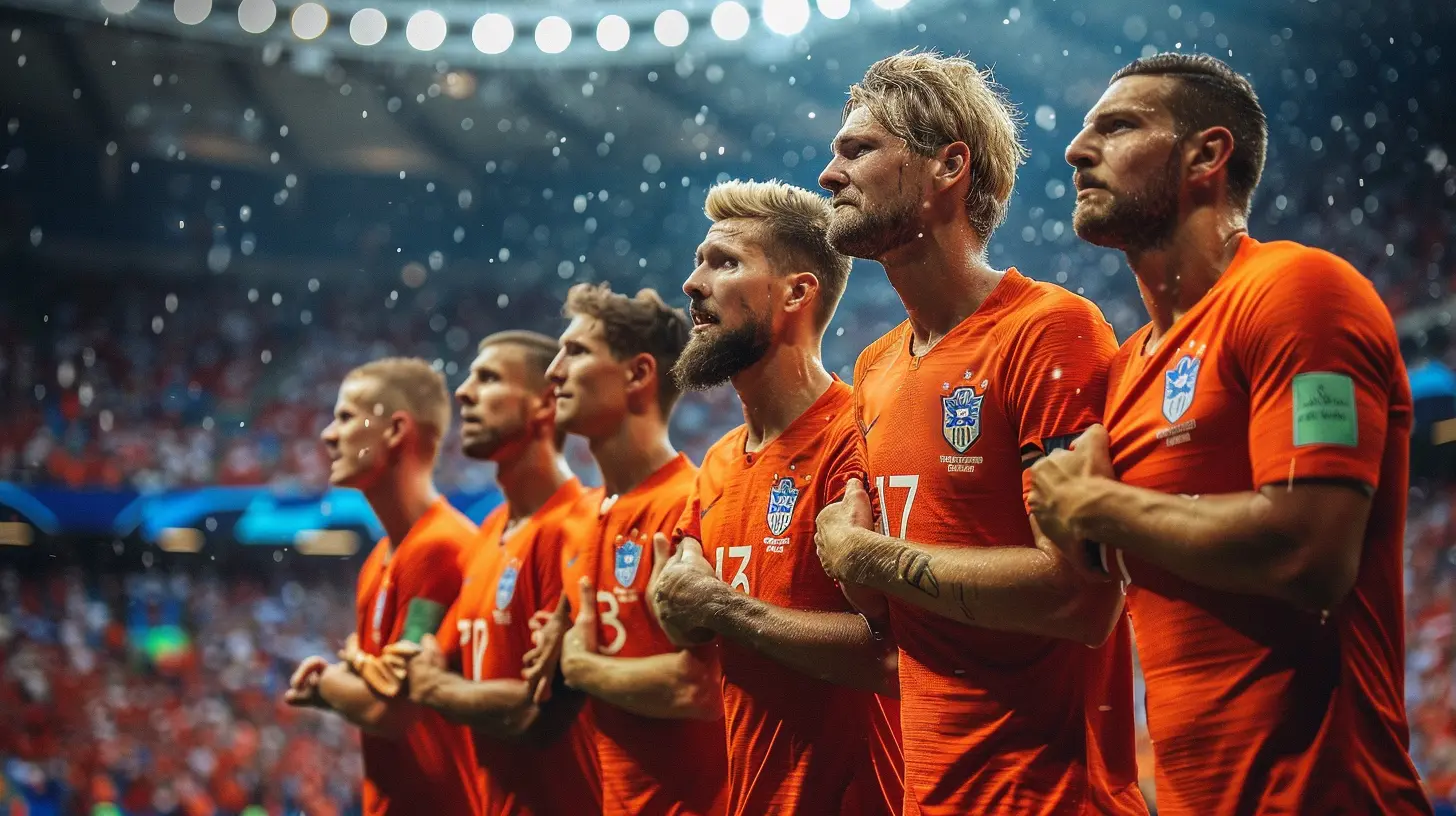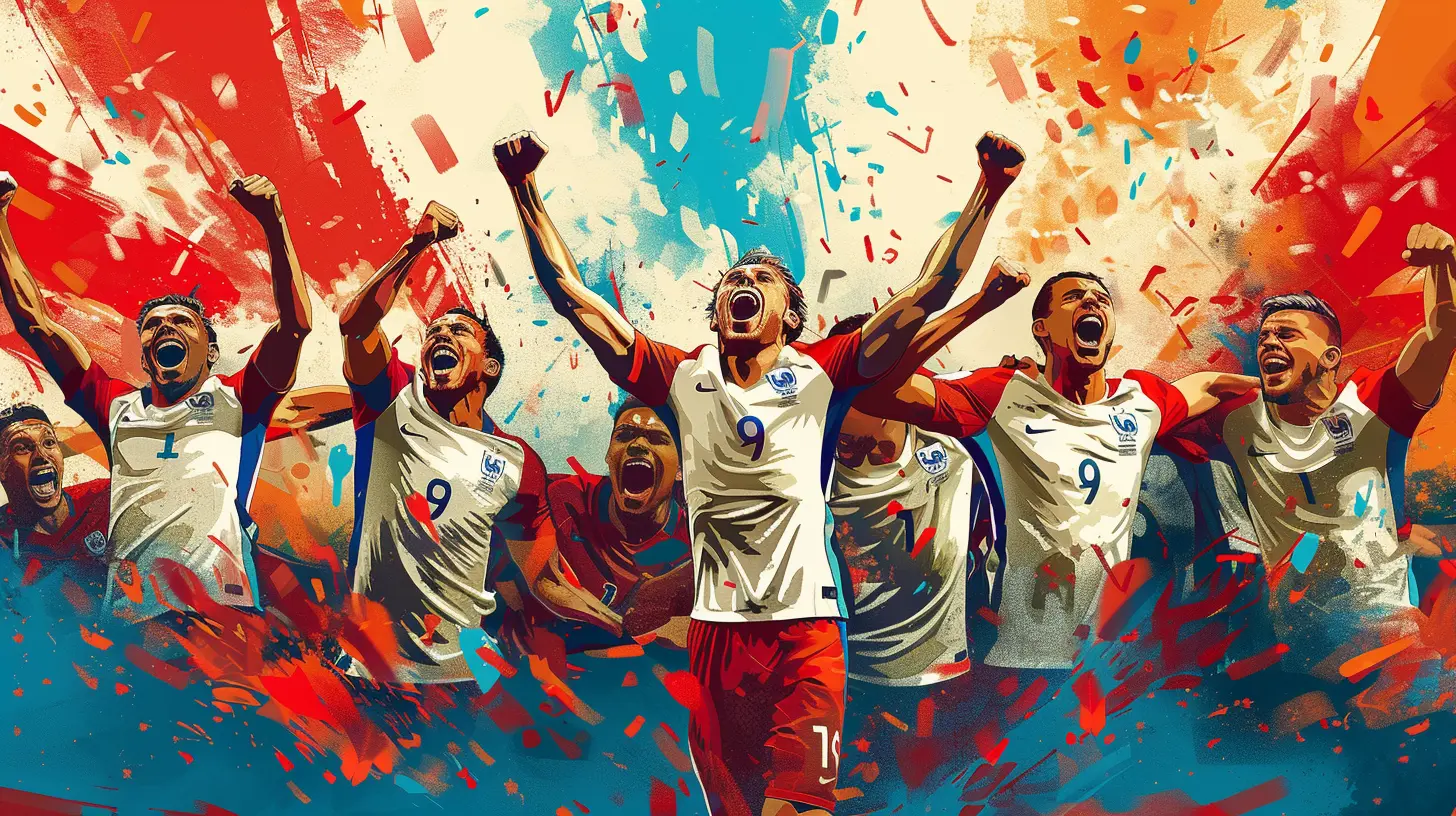The Impact of Club Teams on National Team Success
10 December 2024
When we sit down to watch a big international soccer tournament, it’s easy to get swept up in the excitement of seeing our favorite national teams go head-to-head. But here's a question: how much of that success (or failure) can be traced back to their club teams? More than you might think! National teams may represent a country, but the backbone of their performance is often built on the foundation laid by club teams.
In this article, we’ll dig deep into the relationship between club teams and national squads, uncovering how the former shapes the latter. Whether you’re a die-hard soccer fan or just someone who tunes in for the World Cup, understanding this link will give you a fresh perspective on the beautiful game.

The Role of Club Teams in Player Development
At the heart of any successful national team are its players. These are the stars who make the magic happen on the field. But before they ever don the national jersey, where do they learn their trade? For the vast majority of players, their formative years are spent with club teams.Club Academies: The First Step Toward Stardom
Let’s face it: no one is born a soccer superstar. It takes years of training, dedication, and guidance. Many of these future stars begin their journey in the youth academies of club teams. Clubs like La Masia (the famous FC Barcelona academy) or Manchester United’s youth system are prime examples. These academies don’t just teach players how to kick a ball—they instill a philosophy, a tactical understanding, and the discipline needed to succeed at the highest level.Think of it this way: if a national team is a gourmet dish, the club academies are the kitchens where the ingredients are prepped and perfected. Without that foundation, you’d be left with a pretty underwhelming meal.
Regular Competition Builds Experience
Another crucial aspect of club football is the regular, high-level competition players face week in, week out. Whether it’s the domestic league, domestic cups, or continental tournaments like the Champions League, these competitions provide invaluable experience.Players sharpen their skills, learn to cope under pressure, and adapt to different playing styles. This constant exposure to top-tier competition is impossible to replicate at the national team level, where players only come together a few times a year for qualifiers or major tournaments.
Imagine trying to ace an exam by only studying the night before. That’s what it would be like for national teams without the foundation of club football. The regular grind of club matches ensures that players are always match-fit and tactically sharp when they join their national sides.

Tactical Continuity: Club and National Team Synergy
One of the more fascinating aspects of the club-national team relationship is how tactics can cross over between the two. In some cases, national teams adopt tactical principles that players are already familiar with at the club level, making it easier for them to gel during international duty.Spain’s Tiki-Taka: A Case Study
Remember Spain’s dominance from 2008 to 2012? They won two European Championships and a World Cup in that span, playing some of the most beautiful soccer the world has ever seen. Their success wasn’t just down to individual talent—it was built on the back of a tactical philosophy known as "tiki-taka."But here’s the kicker: tiki-taka wasn’t just a national team strategy. It was something many of Spain’s top players, particularly those from FC Barcelona, were already playing week after week at the club level. When these players came together for the national team, there was no need to start from scratch. Everyone was already on the same page.
In this case, Spain’s national team was essentially a supercharged version of Barcelona, with players seamlessly transitioning from club to country. The result? Global dominance.
Germany’s Gegenpressing Influence
Germany is another excellent example. Around the early 2010s, a tactical revolution called "gegenpressing" (counter-pressing) took hold in the Bundesliga, led by teams like Borussia Dortmund under Jürgen Klopp. Gegenpressing emphasizes winning the ball back immediately after losing it, with high energy and intense pressing.Many players from that system made their way into the German national team, and by 2014, Germany had won the World Cup. The high pressing, quick transitions, and relentless energy they showcased on the international stage were directly influenced by the tactics they practiced regularly at club level.

The Importance of Club-National Team Relationships
As much as club football benefits national teams, the relationship can be a bit of a double-edged sword. After all, clubs and national teams often have conflicting interests. Clubs want their players fit and ready for domestic and international club competitions, while national teams want to call up those same players for international duty.Balancing Player Workloads
One of the biggest challenges for both club and national team coaches is managing player workloads. Modern-day footballers are asked to play a staggering number of matches, often with little rest in between. Overworked players are more likely to get injured, which can be disastrous for both club and country.Club managers like Pep Guardiola or Jürgen Klopp might limit a player’s minutes to keep them fresh for the business end of the season. However, national team managers often have no such luxury. They need their best players available, especially for major tournaments where there's little room for error.
This tension can sometimes lead to players being overworked, or worse, missing out on key matches due to injury. Finding the right balance between club and national commitments is crucial for the long-term success of any player.
Club Facilities and Resources
There’s no denying that top clubs have access to world-class training facilities, medical staff, and technological resources that many national teams simply don’t have. This means that players often return to their national teams in better physical condition than if they were solely reliant on the resources of their national federation.Additionally, clubs often employ sports scientists, nutritionists, and psychologists to ensure their players are performing at the highest level. When these players meet up with their national teams, they bring with them the benefits of these resources.
In many ways, you could argue that national teams are reaping the rewards of investments made by club teams. Without the infrastructure provided by elite clubs, the level of talent and fitness on display at international tournaments would likely be much lower.

The Club vs. National Team Debate
Now, let’s touch on a debate that’s been raging for years: should players prioritize their club teams or their national teams? For some players, representing their country is the pinnacle of their career, the realization of a lifelong dream. For others, club football, with its week-to-week grind and lucrative contracts, takes precedence.The Emotional Appeal of National Football
There’s something undeniably magical about international football. Watching a player score a crucial goal for their country or lift a trophy while draped in their nation’s flag pulls at the heartstrings in a way that club football rarely does.For many players, the honor of representing their country is the ultimate achievement. It’s akin to being called up for a special mission—a chance to make history for their homeland. Think of Cristiano Ronaldo, who has won every club trophy imaginable but holds his Euro 2016 and 2019 Nations League titles in the highest regard.
The Prestige (And Money) of Club Football
On the flip side, club football offers a level of week-to-week consistency and financial reward that international football can’t match. The top European clubs are global brands, offering players unrivaled exposure, massive contracts, and the chance to compete in prestigious competitions like the Champions League.For many players, the day-to-day life of a club footballer is simply more rewarding. The consistency of training with the same group of players, under the same manager, in state-of-the-art facilities is hard to beat.
At the end of the day, it’s not a matter of one being better than the other. Both club and national football are unique in their own right, and both play a crucial role in shaping the careers of players.
Conclusion: A Symbiotic Relationship
So, what’s the final verdict? The impact of club teams on national team success is undeniable. Clubs provide the foundation—through player development, tactical training, and regular competition—on which national team success is built. Without the infrastructure and resources of club football, national teams would struggle to perform at the highest level.But it’s also a symbiotic relationship. National teams provide players with the opportunity to showcase their talents on the world stage, bringing them fame, glory, and a sense of pride that’s hard to replicate in club football.
In the end, both club and national football are essential to the fabric of the game. They fuel each other, pushing players to new heights and giving fans around the world something to cheer for—whether it's on a rainy Tuesday night in Stoke or a sun-soaked evening at the World Cup final.
all images in this post were generated using AI tools
Category:
Club TeamsAuthor:

Umberto Flores
Discussion
rate this article
21 comments
Alisha McWain
Interesting link! How do clubs nurture national talent?
February 28, 2025 at 5:48 AM

Umberto Flores
Clubs nurture national talent by providing training, resources, and competitive environments that enhance player skills and development, ultimately contributing to the success of national teams.
Macey Hernandez
Club teams play a crucial role in shaping national team success by fostering player development, tactical awareness, and competitive experience. The synergy between club and national strategies can significantly enhance performance on the international stage, highlighting the importance of effective collaboration.
February 7, 2025 at 12:49 PM

Umberto Flores
Thank you for your insightful comment! Indeed, the collaboration between club and national teams is vital for nurturing talent and enhancing overall performance on the international stage.
Trevor McManus
Great article! You highlighted the crucial role that club teams play in developing talent for national squads. It's fascinating to see how these connections influence performance on the international stage. Looking forward to more insights on this topic!
February 3, 2025 at 4:09 AM

Umberto Flores
Thank you! I'm glad you found the article insightful. I appreciate your support and will definitely dive deeper into this topic in future pieces!
Mila Cummings
Club dominance directly fuels national team victories—no debate!
January 31, 2025 at 8:40 PM

Umberto Flores
While club success can enhance player development and cohesion, national team victories also depend on tactical execution, player chemistry, and competition context. It's a multifaceted relationship.
Arwen Parker
Great read! It's fascinating how the synergy between club teams and national squads shapes talent development. Club rivalries often fuel a competitive spirit that pushes players to excel. When they bring that passion to the national stage, it really shows. Here’s hoping we see more of that in future tournaments!
January 26, 2025 at 3:31 AM

Umberto Flores
Thank you! I completely agree—club rivalries indeed play a crucial role in developing talent that shines on the national stage. Exciting times ahead!
Zephira Gonzalez
Great article! You highlighted the crucial relationship between club teams and national success. It would be interesting to explore specific examples of players who flourished in club settings, directly enhancing their national team performances during key tournaments. Keep up the good work!
January 21, 2025 at 5:34 AM

Umberto Flores
Thank you for your insightful comment! I appreciate your suggestion and will certainly consider including specific player examples in future discussions.
Cambria Robinson
This article brilliantly highlights the crucial role club teams play in shaping national team performance. The synergy between club success and national pride is undeniable, as strong foundational skills developed at the club level translate directly into international success. A must-read for football enthusiasts!
January 18, 2025 at 3:52 AM

Umberto Flores
Thank you for your insightful comment! I’m glad you found the article highlights the vital connection between club and national team success. Your enthusiasm for the topic is greatly appreciated!
Luna McKnight
Club teams: the secret sauce for national team victories! Go teams!
January 14, 2025 at 5:58 AM

Umberto Flores
Thank you! Club teams play a crucial role in developing players' skills and cohesion, which directly translates to national team success.
Beth Beck
Club teams play a crucial role in developing talent, enhancing national team performance and cohesion.
January 10, 2025 at 5:40 AM

Umberto Flores
Absolutely, club teams are vital for nurturing skills and fostering teamwork, ultimately elevating national team performance.
Paris Blair
Club teams are the backbone of national success; without them, our international dreams would be hollow.
January 8, 2025 at 4:26 AM

Umberto Flores
Absolutely, club teams play a crucial role in developing talent and fostering competitive skills, paving the way for national success.
Fenris Kirk
Club teams play a crucial role in shaping national team success by fostering talent, enhancing skills, and promoting tactical understanding. The synergy between club and country is vital; robust club development creates a pipeline of skilled players, ensuring that national teams are competitive on the global stage.
January 3, 2025 at 3:32 AM

Umberto Flores
Absolutely! Club teams are foundational in developing players' skills and tactics, creating a strong pipeline for national team success. Their role is essential in building competitive squads on the global stage.
Cassidy McIntire
Great article! It's fascinating to see how club teams shape national team success. The synergy between local talent and national pride is crucial. Looking forward to more insights on this important topic in sports!
December 30, 2024 at 1:21 PM

Umberto Flores
Thank you for your insightful comment! I'm glad you enjoyed the article and see the importance of this synergy. Stay tuned for more on this topic!
Felix Maddox
Club teams serve as the foundation for national team success, nurturing talent and fostering teamwork. A strong club culture not only develops individual skills but also builds a cohesive unit, ultimately translating into greater achievements on the international stage.
December 27, 2024 at 8:53 PM

Umberto Flores
Thank you for your insightful comment! I completely agree that a robust club culture is crucial for developing talent and teamwork, which are essential for national team success.
Bryson Wheeler
Ah yes, because clearly, if my local club team wins a match, the national team will suddenly become world champions. Thanks, club soccer, for all that magic!
December 20, 2024 at 8:29 PM

Umberto Flores
Club success can boost player confidence and skill levels, contributing to national team performance, but it's just one piece of a larger puzzle.
Zachary Gomez
Great article! Your analysis on how club teams influence national team performance is insightful. It’s fascinating to see how player development at the club level translates to success on the international stage. Looking forward to more discussions on this topic!
December 18, 2024 at 11:36 AM

Umberto Flores
Thank you for your kind words! I'm glad you found the analysis insightful. I look forward to further discussions on this important topic as well!
Zevin Black
Club teams are the foundation of national success! Their dedication and talent forge strong athletes, uniting skills and passion that elevate the entire sport. Together, we rise! ⚽️🏀
December 15, 2024 at 1:17 PM

Umberto Flores
Absolutely! Club teams play a crucial role in developing skilled athletes, fostering teamwork and dedication that ultimately enhance national team performance. Together, they build a stronger future for the sport!
Alvin McNeal
Club teams are the backbone of national team success. Their ability to develop talent, foster teamwork, and implement strategies directly translates to performance on the international stage. Strong clubs equal strong nations.
December 14, 2024 at 1:22 PM

Umberto Flores
I completely agree! Club teams play a crucial role in nurturing talent and building cohesive strategies, which are essential for national team success. Their influence can't be overstated.
Destiny Cole
Great article! Club teams truly lay the foundation for national team success. Well said!
December 12, 2024 at 9:30 PM

Umberto Flores
Thank you! I'm glad you found the article insightful. Club teams really do play a crucial role in developing talent for national teams.
Candace Jennings
Strong clubs build champions!
December 12, 2024 at 12:13 PM

Umberto Flores
Absolutely! Strong clubs provide the foundation, resources, and competitive environment that develop players into champions, ultimately benefiting national teams.
Soraya Smith
Great insights! Club teams truly shape player development, fostering skills that elevate national team performance. Keep it up!
December 11, 2024 at 9:52 PM

Umberto Flores
Thank you! I'm glad you found the insights valuable. Club teams play a crucial role in developing talent for national success.
Graham McGuffin
This article effectively highlights the crucial role club teams play in developing talent and enhancing national team performance. Strong club programs foster skilled players, ultimately benefiting national success on the international stage.
December 11, 2024 at 5:06 AM

Umberto Flores
Thank you for your insightful comment! I agree that strong club teams are vital for nurturing talent and driving national success.
MORE POSTS

The Rivalry of the Roses: Yorkshire vs. Lancashire in Cricket

How to Develop a Powerful Forehand in Tennis

Betting on Disaster: The Sports Stars Who Gambled Their Careers Away

Mind-Body Connection: Enhancing Your Workouts with Focus

The Rise of Retractable Roofs: How Stadiums are Embracing Flexibility

Fitness and Focus: How Referees Train Like Athletes

The Science Behind Dynamic Warm-Ups for Injury Prevention

Breaking Down the Best Bullpens in Baseball

Behind the Headlines: The True Stories Behind Major Sports Scandals

How to Avoid Plateaus in Your Fitness Progress

How to Use Plyometrics to Boost Your Explosive Power

Post-Workout Routines That Help Prevent Injuries

How Club Teams Can Recover from a Losing Streak